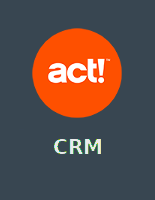Act! User Training course
Training objectives
Master the standard and advanced features of your Act! software. At the end of the day users are operating on the use the software. The administration software is subject to further training of its own. This training can also be provided to the administrator of Act! who can in turn provide this training to end users.
Location
Remotely (preferred) or on our premises.
Duration
1 day (7 hours).
Type of training
Inter-company (grouped).
Intended audience
Act! end users.
Prerequisites
Good knowledge of customer relationship management and flow of the company. Basic understanding of the Windows environment.
Equipment and software
Each attendee must have a computer with the software which is the subject of the training installed. Remote Training courses require an Internet access and a phone or a computer with microphone/speakers (headset recommended). The videoconferencing solution that we are using allows each participant to follow the training from anywhere, by teleworking or from one of his company's sites. Phone calls are free from 34 countries, internet calls are totally free.
|
Course Outline
Act! Installation
- Organized daily work with Act!.
- Presentation of the environment and the different features of the software.
Managing Contacts and Companies
- Presentation of the different fields in the Contact form and company profile.
- Use the Contact tabs and Company.
- How to add / modify / delete a contact / company.
- Management of access rights and privacy.
- How to manage duplicates.
- How to add attachments to contacts.
- How to add secondary contacts.
Group management
- Add / edit / delete groups and subgroups.
- How to add contacts to groups, reform its existing groups.
- Designing static groups and dynamic groups.
Searching for information
- Learn how to sort, select / reorder the columns you need.
- Using the search fields to find contacts / companies.
- Use of keyword searches to find contacts / companies.
- Using advanced queries to find contacts / companies.
- Search for contacts by annual events.
Management of notes and history
- Inserting notes on a contact.
- History records (calls received, calls made, honored appointments, tasks performed, …).
Activities Management and Shared Calendars
- Viewing and printing calendars / task list users.
- Planning activities with contacts (calls to make, appointments to be made, task list, …).
- Change the organization of an activity in terms of date or invitees.
- Handle with invitations sent to participants by email.
- Managing activities in conflict and alarms.
- Planning periodic activities.
- Registration of completed activities.
- Using the notion of sets of activities.
- Managing its activities in the task list (urgent activities, late, …).
- How to display the task list (reordering columns and filtering).
Reports and dashboards
- How to use reports and dashboards existing in Act!.
- Presentation of some of the reports with their use (overview, filtering, export …).
- Printing management.
Act! emailing with Outlook / Lotus or SMTP mode
- The operating principles of Act! and mail coupling.
- Write and send emails from Act! maintaining a level of historical Contacts.
- Management of email for return also in the history of Contacts.
Mail or Word templates
- How to use Act! or Word templates document containing merge fields.
- How to keep track in the history of letters sent.
- How to create a mail with Act!.
Opportunity management
- Opening and use of opportunities.
- Overview of steps in a sales cycle.
- Introduction to Product Management and prices.
- The weighting of the opportunities and managing the closing dates of forecasting to manage its sales forecasts.
- How to manage sales opportunities from inception to its closure (won or lost).
- How to generate reports on their sales forecasts and sales gained.
- Edit the graphics of the evolution of sales and sales funnel.













